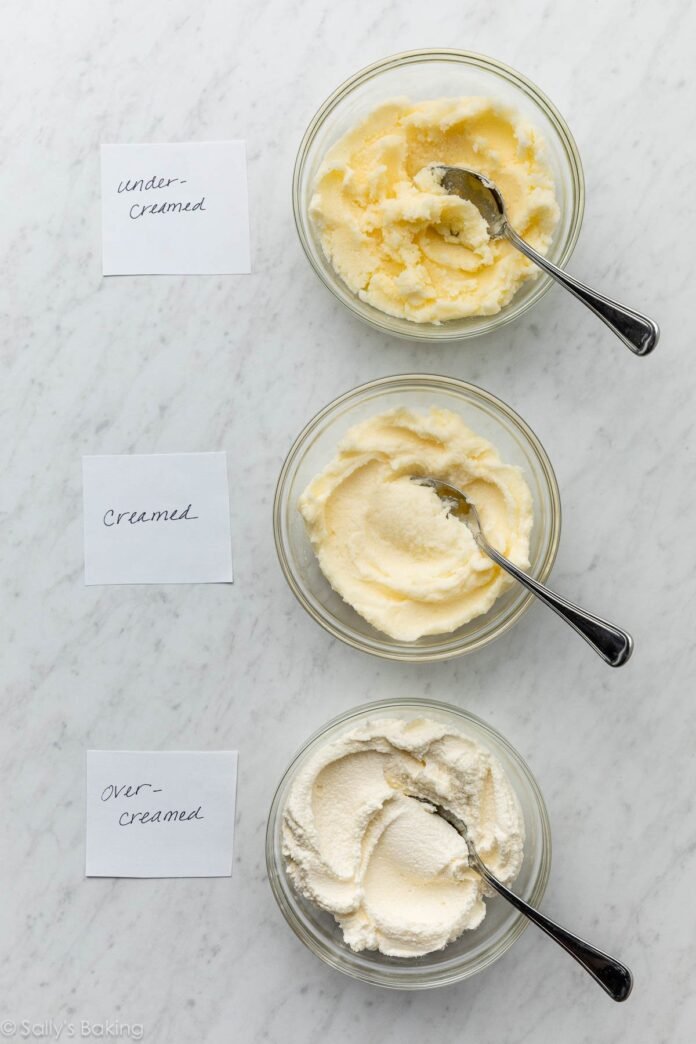Learn how to cream butter and sugar properly, a key step in many baking recipes. If you’ve ever wondered why it’s important, or what would happen if you skipped it, this baking tutorial is for you. Watch the video for even more visuals!
From simple snickerdoodles to tiered a wedding cake, chances are good that if a recipe includes sugar and softened butter, the instructions will call for beating the two ingredients together before you add in the other ingredients.
This is called creaming butter and sugar. But why is it its own step? Why can’t you just throw all the wet ingredients into the mixing bowl at once and get on with it?
How to Cream Butter & Sugar: Video Tutorial
Why It’s Important to Cream Butter & Sugar
Let’s start by going over WHY recipes call for creaming butter and sugar as a step.
The process of creaming room-temperature butter and sugar together is crucial for developing the structure and texture of a baked good. There are three main benefits creaming provides your batter or dough:
- First, beating together incorporates air into the mixture, which gives you a lighter, fluffier crumb. All those teeny-tiny air pockets that are created during creaming then expand during baking. Think: extra soft cupcakes and and tall, fluffy cake layers. Without creaming, your baked good will end up dense.
- Second, the butter is broken down (no lumps!) and the sugar crystals are more evenly distributed throughout, so your baked goods are soft, not gritty.
- And third, creaming butter and sugar together creates structure and makes for a stable base to add the remaining ingredients to. There’s magic (or rather, science!) happening in there, building a network of fat, sugar, and air.
Now let’s go over HOW to cream butter and sugar.
Use a Mixer
The first important part is to use an electric mixer. Even if you have super strong arm muscles from kneading dough, it would take at least 10 minutes of vigorous stirring to cream butter and sugar by hand; and even then, you likely won’t get the same light and fluffy result.
I recommend using a stand mixer or a handheld mixer to cream butter and sugar. If you’re using a stand mixer, make sure you use the paddle attachment.
Use Softened Butter That’s Still Cool
Did you know that proper room-temperature butter does not mean that the butter is the exact same temperature as your kitchen? It should actually still feel cool to the touch.
When butter is cool, it’s capable of trapping air. If it gets too warm, it loses that ability, and your creaming will all be for nothing—a waste of both your time and your ingredients!
You want to aim for a butter temperature of about 65°F (18°C). The butter will gradually warm up during the creaming process, so err on the cooler side—better to be under 65° than over at the start. An instant-read thermometer can take the guesswork out of this!
Beat on Medium Speed for About 5 Minutes
Start the mixer on low speed and gradually increase it as the sugar gets combined with the butter. It takes about 5 minutes of beating on medium speed to reach that perfect pale yellow color and light and fluffy texture you are looking for.
Sometimes I speed things up a bit and beat on medium-high speed for about 3 minutes.
Success Tip: stop and scrape. Stop the mixer at least once during this time and scrape down the sides of the bowl. Some butter and sugar can stick to the sides of the bowl, and we want the mixture to all come together evenly.
Properly Creamed Butter & Sugar, 3–5 Minutes
Properly creamed butter and sugar is a very pale yellow color. The sugar granules are evenly dispersed, there are no visible chunks of butter, and the texture looks fluffy, not greasy.
Here is what creamed butter and sugar looks like:
Under-Creamed Butter & Sugar, 1 Minute
Before butter and sugar reaches the point of properly creamed, described above, it’s not nearly as light and fluffy. With only around 1 minute of beating, the butter and sugar mixture is clumpy, you’ll likely see pieces of butter, and the sugar hasn’t begun to dissolve. If you were to add your remaining ingredients at this point, your batter would look like a chunky soup, instead of the smooth, velvety cupcake batter we’re aiming for.
Here is what under-creamed butter and sugar looks like:
Over-Creamed Butter & Sugar, 7 Minutes
On the other end of the spectrum, it’s possible to over-cream butter and sugar. If you’re using a stand mixer and walk away from it, that’s when you could accidentally make this mistake. After around 7+ minutes of beating, the color is really light, and the mixture looks greasy and overly soft, not fluffy.
Here is what over-creamed butter and sugar looks like:
Comparison in a Baked Good
My team and I tested what would happen if we under-creamed and over-creamed butter and sugar. For this baking experiment, we used my favorite vanilla cupcakes recipe.
- Under-creamed butter and sugar: The cupcakes were short and squat, dense and spongey, and the surface was pockmarked with holes from where the too-big chunks of butter that didn’t get broken down by the mixer caused steam to tunnel out through the surface. The sugar didn’t dissolve properly, either, so the result was a grainy, uneven crumb. They tasted awful.
- Properly creamed butter and sugar: We know the perfectly creamed version works! When made properly, these cupcakes have an airy and springy crumb, and rise just over the top of the cupcake liner without spilling over the sides into mushroom tops. This was our control, or baseline for comparison.
- Over-creamed butter and sugar: These were some sad, sunken cupcakes. If the batter has too much air in it, the cupcakes will quickly rise high in the oven, and then collapse or sink in the center as they cool. And if the butter warms up too much from excessive beating, cookies and cupcakes end up spreading OUT instead of rising UP. The too-soft butter can also make for a greasy baked good.
Now that you know why creaming butter and sugar is key to light, fluffy bakes, you’re one step closer to your cookies and cakes turning out perfectly on the first try. Happy baking!
Want to Learn More?
My Baking Tips & Tutorials section is always growing:






